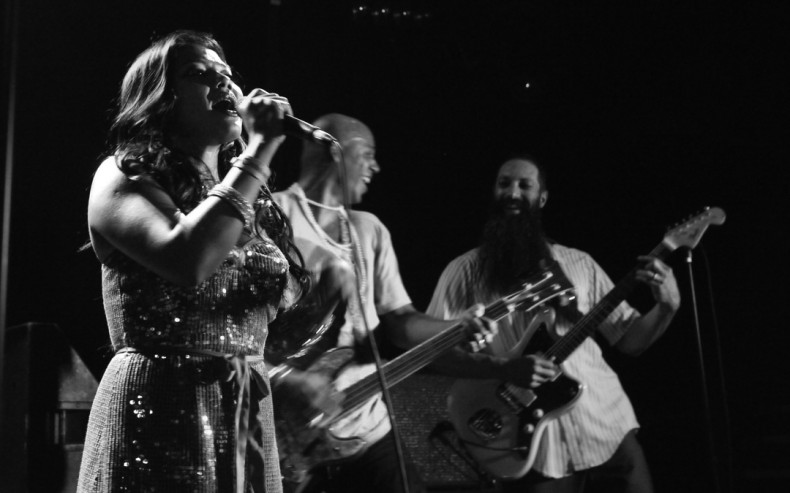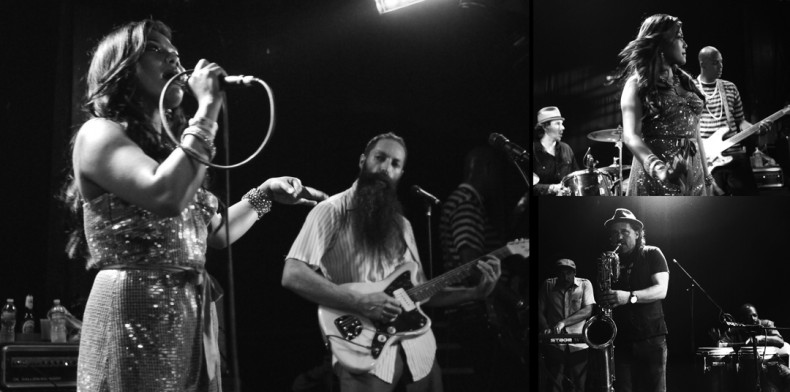Aug 26, 2014 That time I caught Dengue Fever

It was way back in 2002 but I vividly recall driving from my home in Silver Lake to the Giant Robot garage off Sawtelle, listening to KXLU, and hearing what sounded like vintage garage rock from Cambodia. The LMU station is rightfully famous for championing all sorts of great punk rock, post punk, and noise music but this was something completely wild and different. The surfing and spying guitars were as hook-laden as they were blown-out, lifted by an otherworldly, too-good-to-be-true voice that seemed to be the missing link between the Cocteau Twins’ heavenly Elizabeth Fraser and the Cantopop idol from outer space Faye Wong. Wow. I cranked it up.
Upon reaching my destination, I dialed the radio station and asked the DJ what the hell I just heard. He said it was a new group called Dengue Fever that hadn’t released any records yet. One of the band members provided a demo. Did I want his phone number?
It turns out the bass player Senon lived in Los Feliz, just a couple of minutes from my place, and he was familiar with the magazine that I helped found and edited. One thing led to another, and I was invited to meet the band for dinner at a Cambodian restaurant called Dragon House in Long Beach.
Back then, the group was still in an embryonic stage and Nimol’s grasp of English was just as raw. She was accompanied by a Cambodian girlfriend, presumably so she wouldn’t be alone amongst a bunch of potentially sketchy musician dudes–even if they happened to be associated with notable acts such as Radar Bros., Dieselhed, and Beck. It was the guys that did most of the talking and they weren’t creepy at all.
At the restaurant, which was more like a nightclub, the keyboard player Ethan revealed how he became obsessed with Cambodian psychedelic rock during a backpacking trip through Southeast Asia in the late ’90s. Hearing it in a taxi resulted in relentless visits to music shops and a bagful of cassettes that he shared with his brother, guitarist Zac, who had really gotten into the genre as well. With their minds on fire with the concept of forming a kick-ass group that would perform this obscure-yet-amazing style of music, they began to comb Long Beach’s Little Phnom Penh in search of an authentic Khmer singer. The stars aligned. Ethan and Zac found Nimol, whose family was Cambodian pop royalty and who was already a star in the local party circuit. Somehow, they convinced her to try playing dive bars and rock clubs with their new band.
Dragon House was dark and loud and it wasn’t easy to keep track of what each of the guys was saying, but what happened next blew my mind clean anyway. The cheesy Khmer lounge act put down their instruments and Dengue Fever excused themselves to go onstage. Just like that, the somewhat geriatric club was transformed into the coolest spot on the planet. The songs were still classic Cambodian pop, but they were filtered through a killer combination of DIY, art school, and rock ‘n’ roll sensibilities without being ruined by one iota of irony. The locals dug it, too, and a circle of dancers began to snake around the dancefloor.
At that moment I became the band’s number-one fan, and proceeded to witness them freaking out swing dancers at The Derby and Mike Watt fans at the Knitting Factory alike. I’d like to think I wrote the first full-on article about Dengue Fever in Giant Robot, following up with sympathetic coverage when Nimol got detained at the border on the way back from a show in San Diego and sharing a glorious travel piece when the band made its first trip to Cambodia.
It was exciting to see Dengue Fever get bigger–but not in the sense of selling a million records, although they really should have been. The ripple effect of their resuscitating a rad sliver of music that was nearly buried in the Killing Fields by the Khmer Rouge not only made a dent in the indie charts, rock clubs, and occasional festivals but also sparked a new interest in the dusty genre among Cambodian immigrants as well as in the motherland itself. Life was imitating art imitating life, but what’s the difference if you can do the frug to both?
More than ten years, five albums, and one soundtrack later, we’ve kept in touch and I seem to see them hanging out at our kids’ parties as often as I do at Dengue Fever gigs. Meanwhile, the band’s music still affects me the same way it did when I first happened upon it on the radio. Indeed, the band’s concept has evolved from ramped-up Khmer covers into a even wilder mutation of song from another dimension but that’s another story…
More information on Dengue Fever (including upcoming gigs in Phoenix, San Diego, and Long Beach) can be found at denguefevermusic.com. And check in on Imprint Culture Lab via Twitter, Instagram, and Facebook for more articles, events, and announcements.



